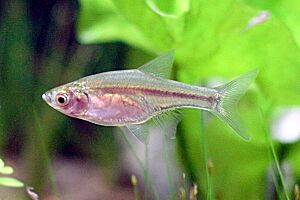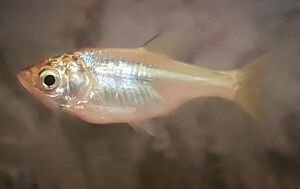Princess carplet facts for kids
Quick facts for kids Princess carplet |
|
|---|---|
 |
|
| Conservation status | |
| Scientific classification | |
| Genus: |
Amblypharyngodon
|
| Species: |
chulabhornae
|
The princess carplet, also known as Amblypharyngodon chulabhornae, is a small and interesting fish. It belongs to the carp family. You can find this fish in rivers and wetlands across mainland Southeast Asia. It's a common and important part of its watery homes!
Contents
About the Princess Carplet
The princess carplet is a small fish, usually growing to be about 3 to 4 centimeters long. That's about the length of your thumb! Female carplets can grow a little bigger than males. They also have a more rounded belly when they are ready to lay eggs.
This fish has a golden body. It also has pretty blue eyes. It does not have any whiskers around its mouth. The princess carplet has special fins. It has 10 soft rays in its top fin, called the dorsal fin. It also has 8 soft rays in its bottom fin, called the anal fin.
Scientists can tell this fish apart from other similar species. They count the scales on its side. The princess carplet has fewer scales, usually 42 to 50. Other fish in its group have more.
Where They Live
Princess carplets live in shallow, calm waters. You can often find them in paddy fields, which are fields where rice is grown. They also live in ditches and other small water areas. They really like places with lots of plants. This includes floating plants and plants that grow out of the water. They also like areas that get flooded with water during certain seasons.
These fish are found in several countries in Southeast Asia. They live in the Chao Phraya and Mekong river systems. These rivers flow through Thailand, Laos, and Cambodia. They are also found in the Mae Klong river basin. This area is in southeast Thailand and goes down into the upper part of the Thai-Malay peninsula. It seems they might have also been brought to Singapore and now live there too.
Princess Carplet Habits and Life
Princess carplets are social fish. They like to live together in small groups, called schools. This helps them stay safe from bigger fish.
They probably eat tiny creatures, like small invertebrates. They also eat zooplankton, which are tiny animals that float in the water. Sometimes, they might eat algae too.
When it's time to have babies, princess carplets lay their eggs. They likely scatter their eggs on the bottom of the water. After the eggs are laid, the parent fish do not take care of them. The eggs hatch on their own.
Protecting the Princess Carplet
The princess carplet is still a common fish. Because of this, the IUCN (International Union for Conservation of Nature) lists it as "Least Concern." This means it's not in danger of disappearing right now.
However, in some places, their numbers are going down. For example, in parts of Thailand, fewer carplets are being seen. But in other areas, like around Phnom Penh, they are still very common.
Princess carplets are not usually sold in fish markets. Sometimes, local fishermen might catch them for food. The biggest problem for these fish seems to be pollution in the water. They are rarely sold as aquarium pets. If you see them for sale, it's probably because they were accidentally caught while fishermen were trying to catch other types of fish.
Naming the Princess Carplet
The name Amblypharyngodon chulabhornae has a special meaning. The first part, Amblypharyngodon, comes from old Greek words. Amblús means "blunted," and pháruks means "throat." Odṓn means "toothed." This name describes the shape of the fish's pharyngeal teeth, which are teeth in its throat.
The second part of the name, chulabhornae, honors someone very important. It is named after Her Royal Highness Princess Chulabhorn Mahidol of Thailand. This was done to recognize her strong interest in science and technology.



